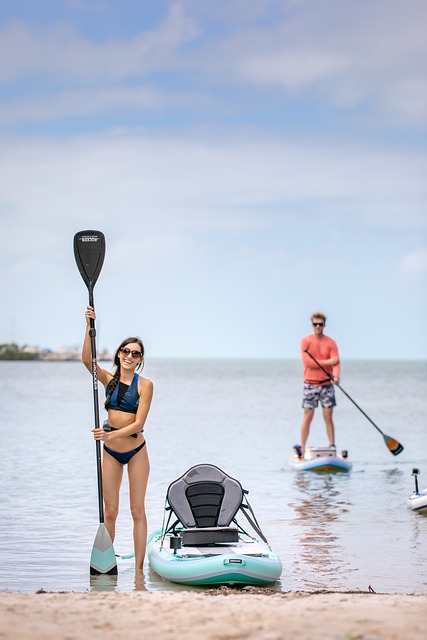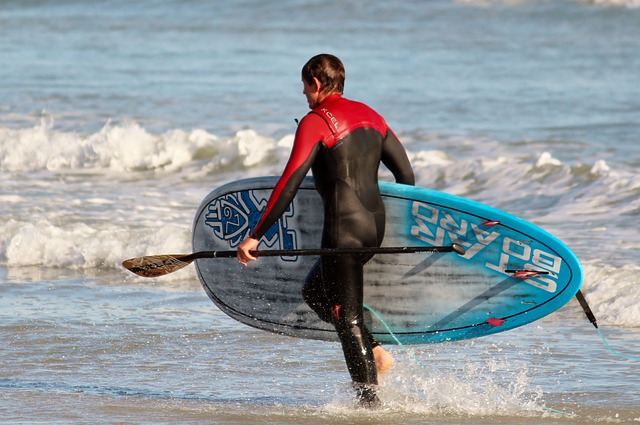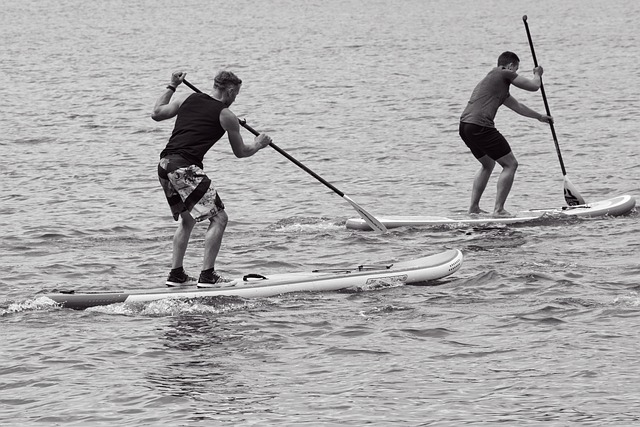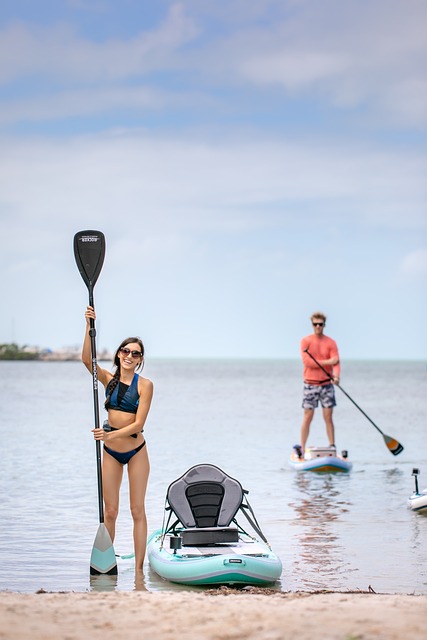Inflatable Paddle Boards (IPS) have revolutionized water sports with their portability and performance. When choosing a top model, consider size, shape, carry handles, fins, pockets, quick-fill valves, and versatility. The stiffness of an IPS is determined by material construction and design—high-quality PVC or drop-stitch fabric ensures rigidity when inflated. A stiff board enhances stability and control, enabling faster speeds and improved maneuverability. Prioritize high-density materials for durability; thick walls offer puncture resistance. Sturdy designs provide enhanced performance, smoother turns, and better balance in various water conditions. User feedback highlights the IPS's unique blend of rigidness and portability. Proper care, including drying, storage, cleaning, and regular inspection, ensures your best inflatable paddle board maintains optimal condition for years of enjoyment.
“Discover the secret to enhancing your paddle boarding experience with a stiff design when inflated. This comprehensive guide explores the ins and outs of choosing the ideal best inflatable paddle board (IPB). From understanding the basics and exploring factors affecting stiffness to unlocking performance potential, we delve into key considerations. Learn why a rigid board is essential for a smooth ride and explore best practices for selection. Gain insights from real-world applications and maintenance tips to ensure your IPB maintains optimal stiffness.”
Understanding Inflatable Paddle Boards: The Basics

Inflatable paddle boards, also known as IPS, have revolutionized water sports due to their portability and ease of use. These boards are designed to be lightweight yet sturdy when inflated, offering a unique blend of performance and convenience. The best inflatable paddle board combines robust materials like PVC or drop-stitch fabric with air chambers that provide stability and buoyancy. This makes them suitable for various water activities, from calm lakes to choppy seas.
When choosing the top inflatable paddle board, consider factors such as size (influencing speed and maneuverability), shape (different designs cater to specific sports like surfing or yoga), and additional features like integrated carry handles, adjustable fins, and cargo pockets. The best models offer a seamless transition from packed to inflated, often featuring quick-fill valves for faster setup. This versatility ensures that the best inflatable paddle board is not just a one-season wonder but a reliable companion for years of aquatic adventures.
Factors Affecting Stiffness in Inflatables

The stiffness of an inflatable, particularly a best inflatable paddle board, is influenced by several key factors. One of the primary considerations is the material used in construction. High-quality, durable materials like drop-stitch fabric or PVC offer superior rigidity when inflated, ensuring a more responsive and stable ride. The thickness and density of these materials play a crucial role in determining how well they withstand pressure and maintain their structural integrity.
Another important factor is the design itself. Complex geometric patterns and interconnected chambers can significantly enhance a paddle board’s stiffness. These designs distribute air pressure evenly across the surface, reducing the risk of deformation or sagging. For instance, many top-rated inflatable paddle boards feature multiple internal chambers that work in harmony to provide a rigid and balanced platform, making them ideal for activities like paddling and yoga.
Why Stiff Design is Key for Performance

When it comes to top-performing best inflatable paddle boards, stiff design is a key factor that sets them apart from their softer counterparts. This rigidity plays a crucial role in enhancing stability and control while paddling, making it easier for users to cut through water with precision and efficiency. A stiff board provides a solid platform, ensuring your strokes are more effective, which directly translates into faster speeds and improved maneuverability.
For paddlers seeking the ultimate in performance, a well-designed inflatable paddleboard offers a balance between being robust enough to withstand rigorous use and flexible enough to provide comfort during extended sessions. This unique blend of attributes allows athletes to push their limits, whether they’re competing in races or simply enjoying a challenging workout on calm waters.
Best Practices for Choosing the Rigid Board

When selecting a rigid board for your best inflatable paddle board, consider material as a top priority. High-quality materials like EPS (Expanded Polystyrene) or PVC offer superior strength and durability, ensuring your board can withstand repeated inflation and deflation without compromising structure. Look for boards with thick, robust walls to enhance stability and prevent punctures.
Additionally, choose a design that balances rigidity and flexibility. A stiff yet responsive board provides better control and maneuverability during paddling, making it ideal for various water activities. Ensure the board’s shape and fin placement align with your preferred paddling style, whether it’s surfing, cruising, or racing. This attention to detail will contribute to a more enjoyable and efficient paddling experience.
Unlocking Benefits of a Sturdy Inflatable

Sturdy designs in inflatable products, such as the best inflatable paddle board, offer a range of benefits beyond their lightweight and portable nature. While many may assume that a stiffer structure limits the versatility of inflatables, this isn’t the case. In fact, a well-crafted, rigid inflatable provides enhanced performance and stability for various water activities.
When you invest in a top-quality paddle board with a robust construction, it becomes more responsive to your movements, allowing for smoother turns and faster acceleration. This stiffness also ensures better balance and control during paddling, making it easier to navigate choppy waters or maintain steady strokes for longer periods. Moreover, stiffer designs often offer increased durability, resisting punctures and tears, which is crucial for outdoor enthusiasts who rely on their gear for frequent adventures.
Real-World Applications and User Feedback

In real-world applications, stiff design when inflated has proven to be a game-changer in various outdoor activities, particularly with the rise of best inflatable paddle boards (IPSBs). These boards offer unparalleled stability and performance on water, making them a preferred choice for paddlers seeking versatility and convenience. User feedback highlights the remarkable balance between rigidness and portability that IPSBs provide, allowing users to easily transport and set up their gear without sacrificing quality.
The innovative design translates into enhanced user experiences across different scenarios, from serene lakes to choppy seas. Paddlers appreciate the stiff structure’s ability to maintain its shape during use, ensuring a smooth and efficient paddling motion. This feature is especially beneficial for long-distance trips or competitive events where every stroke counts. Moreover, the feedback underscores how IPSBs’ durability and resilience stand up to rigorous use, making them a reliable companion for outdoor enthusiasts seeking an elevated paddling experience.
Maintenance Tips to Retain Optimal Stiffness

To maintain the optimal stiffness of your best inflatable paddle board, regular care is essential. Start by thoroughly drying your board after each use to prevent moisture buildup, which can weaken the material over time. Store it in a cool, dry place when not in use to avoid prolonged exposure to direct sunlight or extreme temperatures, both of which can cause damage and reduce stiffness.
Regular cleaning with mild soap and warm water is recommended to remove any dirt or salt residue. Avoid using harsh chemicals or abrasive materials that could scratch the surface. Additionally, periodically inspect the board for any signs of wear and tear, such as punctures or tears, and address these issues promptly to maintain structural integrity.
